|
Lizard |
||||||||||
|---|---|---|---|---|---|---|---|---|---|---|
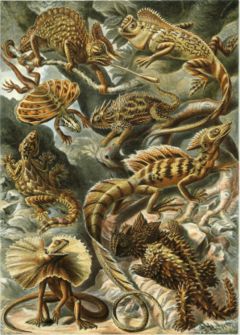
"Lacertilla", from Ernst
Haeckel's Artforms of Nature, 1904
|
||||||||||
| Scientific classification | ||||||||||
|
||||||||||
| Many, see text. |
Lizards are reptiles of the order Squamata, which they share with the snakes (Ophidians). They are usually four-legged, with external ear openings and movable eyelids. Species range in adult length from a few centimeters (some Caribbean geckos) to nearly three meters (Komodo dragons).
Some lizard species called "glass snakes" or "glass lizards" have no functional legs, though there are some vestigial skeletal leg structures. They are distinguished from true snakes by the presence of eyelids and ears. The tail of glass lizards, like many other lizards, will break off as a defense mechanism, unlike snakes.
Many lizards can change color in response to their environments or in times of stress. The most familiar example is the chameleon, but more subtle color changes occur in other lizard species as well (most notably the anole, also known as the "house chameleon" or "chamele").
Lizards typically feed on insects or rodents. A few species are omnivorous or herbivorous; a familiar example of the latter is the iguana, which is unable to properly digest animal protein. Until very recently, it was thought that only two lizard species were venomous: the Mexican beaded lizard and the closely-related Gila monster, both of which live in northern Mexico and the southwest United States. However recent research at the University of Melbourne, Australia and Pennsylvania State University has revealed that in fact many lizards in the iguanians and monitor (lizard) families have venom-producing glands. None of these poses much danger to humans, as their poison is introduced slowly by chewing, rather than injected as with poisonous snakes. Nine toxins previously thought to only occur in snakes have been discovered, and a number of previously unseen chemicals as well.
These revelations are prompting calls for a complete overhaul of the classification system for lizard species to form a venom clade. "These papers threaten to radically change our concepts of lizard and snake evolution, and particularly of venom evolution," says Harry Greene, a herpetologist at Cornell University in New York.
Most other lizard species are harmless to humans (most species native to North America, for example, are incapable even of drawing blood with their bites). Only the very largest lizard species pose threat of death; the Komodo dragon, for example, has been known to attack and kill humans and their livestock. The Gila Monster and Beaded Lizard are venomous however, and though not deadly, can inflict extremely painful and powerful bites. The chief impact of lizards on humans is positive; they are significant predators of pest species; numerous species are prominent in the pet trade; some are eaten as food (for example, iguanas in Central America); and lizard symbology plays important, though rarely predominant roles in some cultures (e.g. Tarrotarro in Australian mythology).
Most lizards lay eggs, though a few species are capable of live birth. Many are also capable of regeneration of lost limbs or tails.
Lizards in the Scincomorpha family, which include skinks (such as the blue-tailed skink), often have shiny, iridescent scales that appear moist. However, like all other lizards, they are dry-skinned and generally prefer to avoid water. All lizards are able to swim if needed, however, and a few (such as the Nile monitor) are quite comfortable in aquatic environments.
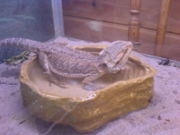
Lizards as pets
Many species of lizard are now sold as pet species. A few of these include iguanas, bearded dragon, leopard geckos, tegus, and monitor lizards to name a few. In general, lizards require more maintenance than other exotic pets, particularly snakes and tarantulas. Their feces are usually more offensive, requiring frequent cage cleanings.
Classification
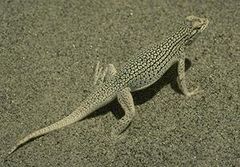
Coachella Valley Fringe-toed Lizard,
Uma inornata
|
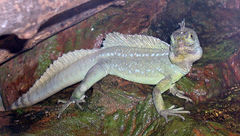
Plumed Basilisk, Basiliscus
plumifrons
|
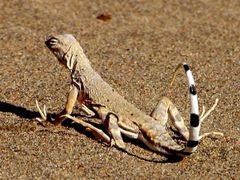
Zebra-tailed Lizard, Callisaurus
draconoides
|
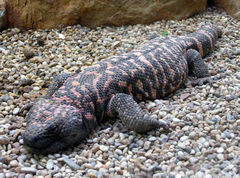
Gila monster, Heloderma s.
suspectum
|
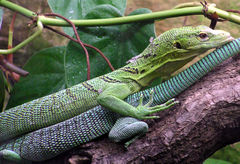
Green tree
monitor lizard, Varanus prasinus
|
Suborder Lacertilia (Sauria) - (Lizards)
- †Family Bavarisauridae
- †Family Eichstaettisauridae
- Infraorder Iguania
- †Family Arretosauridae
†Family Euposauridae
Family Corytophanidae (casquehead lizards)
Family Iguanidae (iguanas and spinytail iguanas)
Family Phrynosomatidae (earless, spiny, tree, side-blotched and horned lizards) - Family
Polychrotidae (anoles)
- Family Leiosauridae (see Polychrotinae)
- Family
Tropiduridae (neotropical ground lizards)
- Family Liolaemidae (see Tropidurinae)
Family Leiocephalidae (see Tropidurinae)
- Family Liolaemidae (see Tropidurinae)
- Family Crotaphytidae (collared and leopard
lizards)
Family Opluridae (Madagascar iguanids)
Family Hoplocercidae (wood lizards, clubtails)
†Family Priscagamidae
†Family Isodontosauridae
Family Agamidae (agamas)
Family Chamaeleonidae (chameleons)
- †Family Arretosauridae
- Infraorder
Gekkota
- Family Gekkonidae (geckos)
Family Pygopodidae (legless lizards)
Family Dibamidae (blind lizards)
- Family Gekkonidae (geckos)
- Infraorder
Scincomorpha
- †Family Paramacellodidae
†Family Slavoiidae
Family Scincidae (skinks)
Family Cordylidae (spinytail lizards)
Family Gerrhosauridae (plated lizards)
Family Xantusiidae (night lizards)
Family Lacertidae (wall lizards or true lizards)
†Family Mongolochamopidae
†Family Adamisauridae
Family Teiidae (tegus and whiptails)
Family Gymnophthalmidae (spectacled lizards)
- †Family Paramacellodidae
- Infraorder
Diploglossa
- Family Anguidae (glass lizards)
Family Anniellidae (American legless lizards)
Family Xenosauridae (knob-scaled lizards)
- Family Anguidae (glass lizards)
- Infraorder
Platynota (Varanoidea)
- Family Varanidae (monitor lizards)
Family Lanthanotidae (earless monitor lizards)
Family Helodermatidae (gila monsters)
†Family Mosasauridae (marine lizards)
- Family Varanidae (monitor lizards)
References
- Anthony Herrel's lizard page
- The EMBL reptile database
- Tiny gecko - the 'world's smallest' lizard
- Venom found to be widespread in lizards [1]